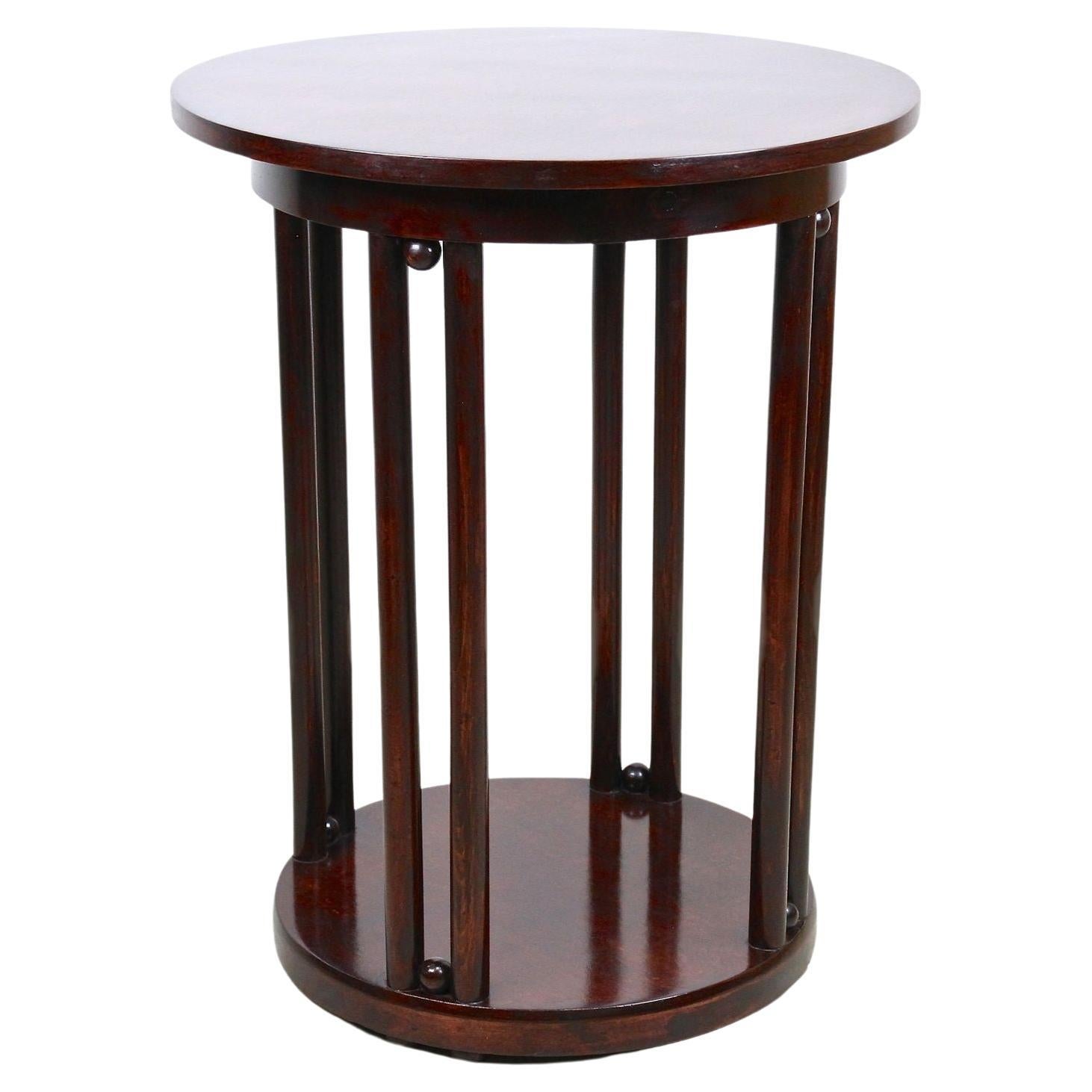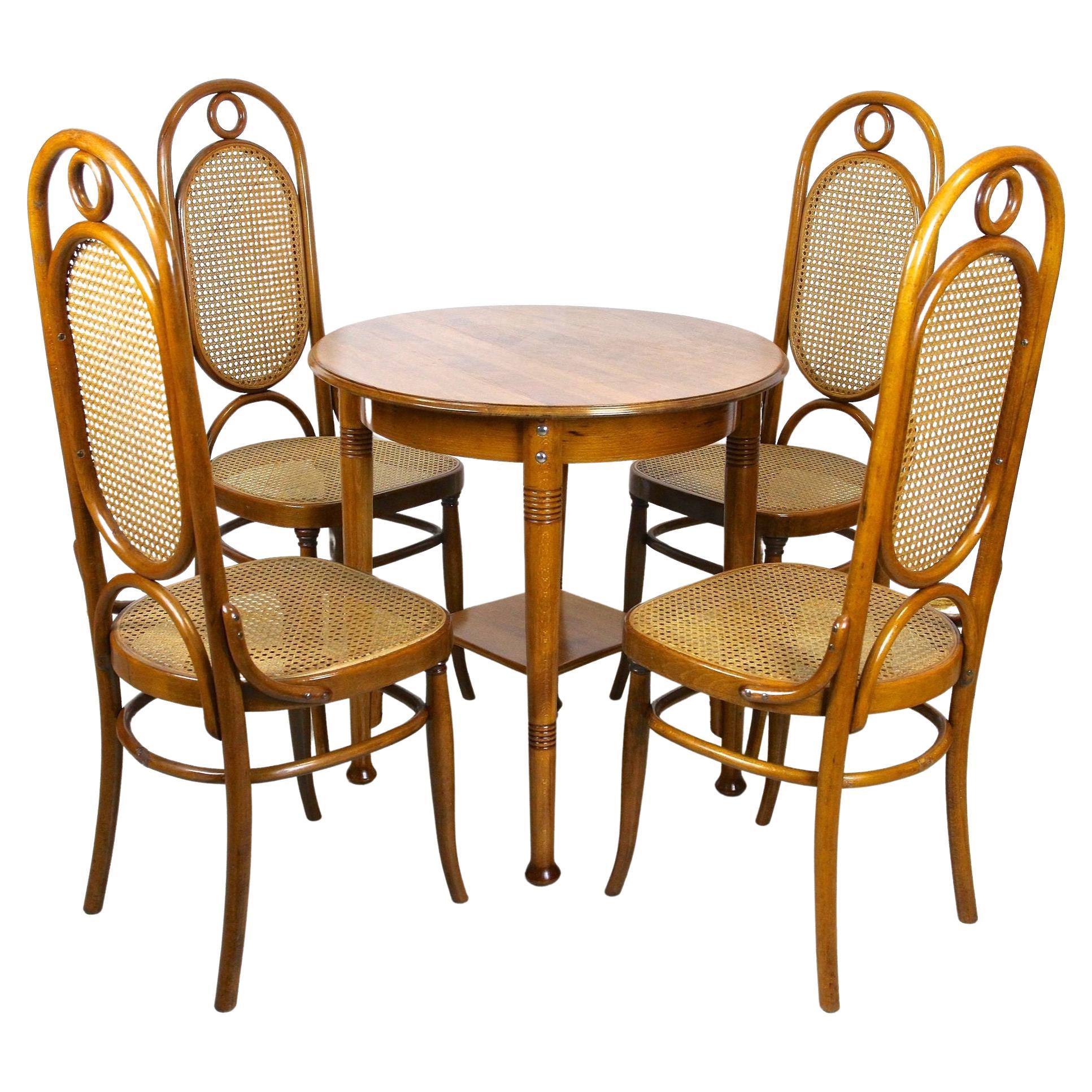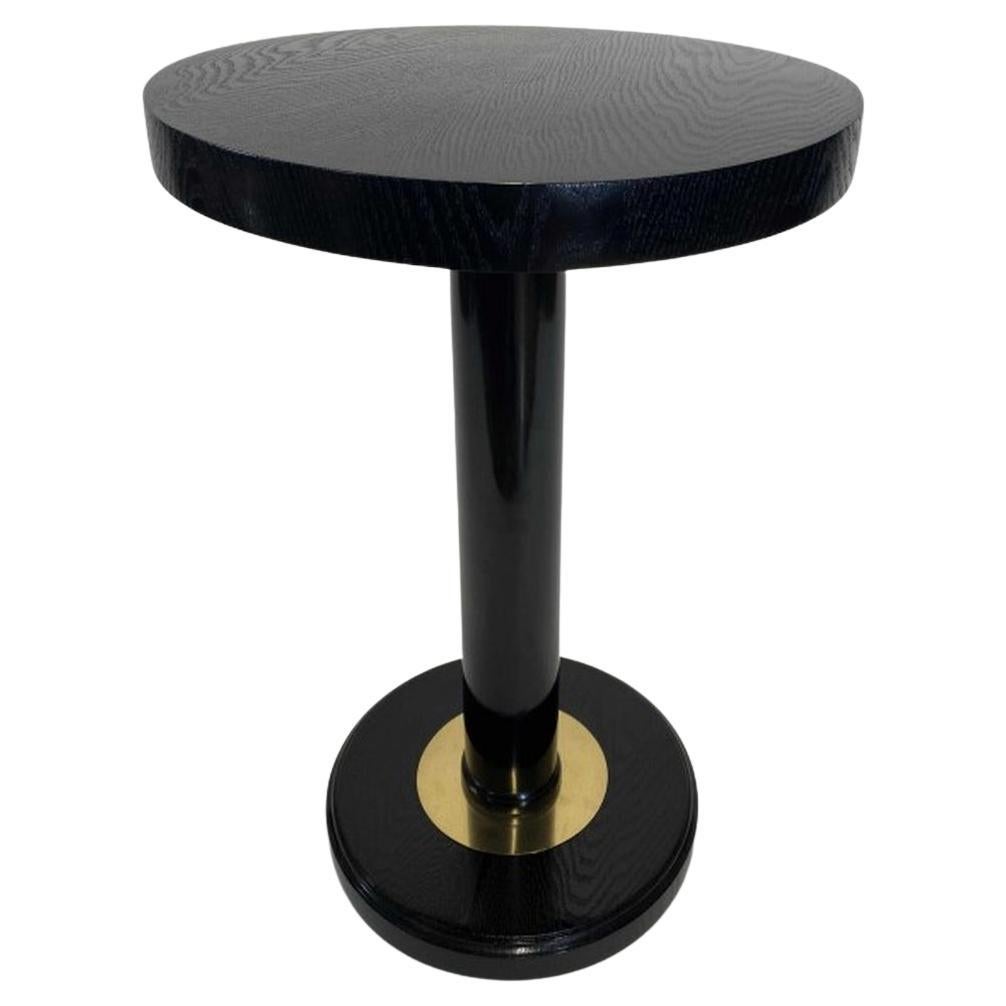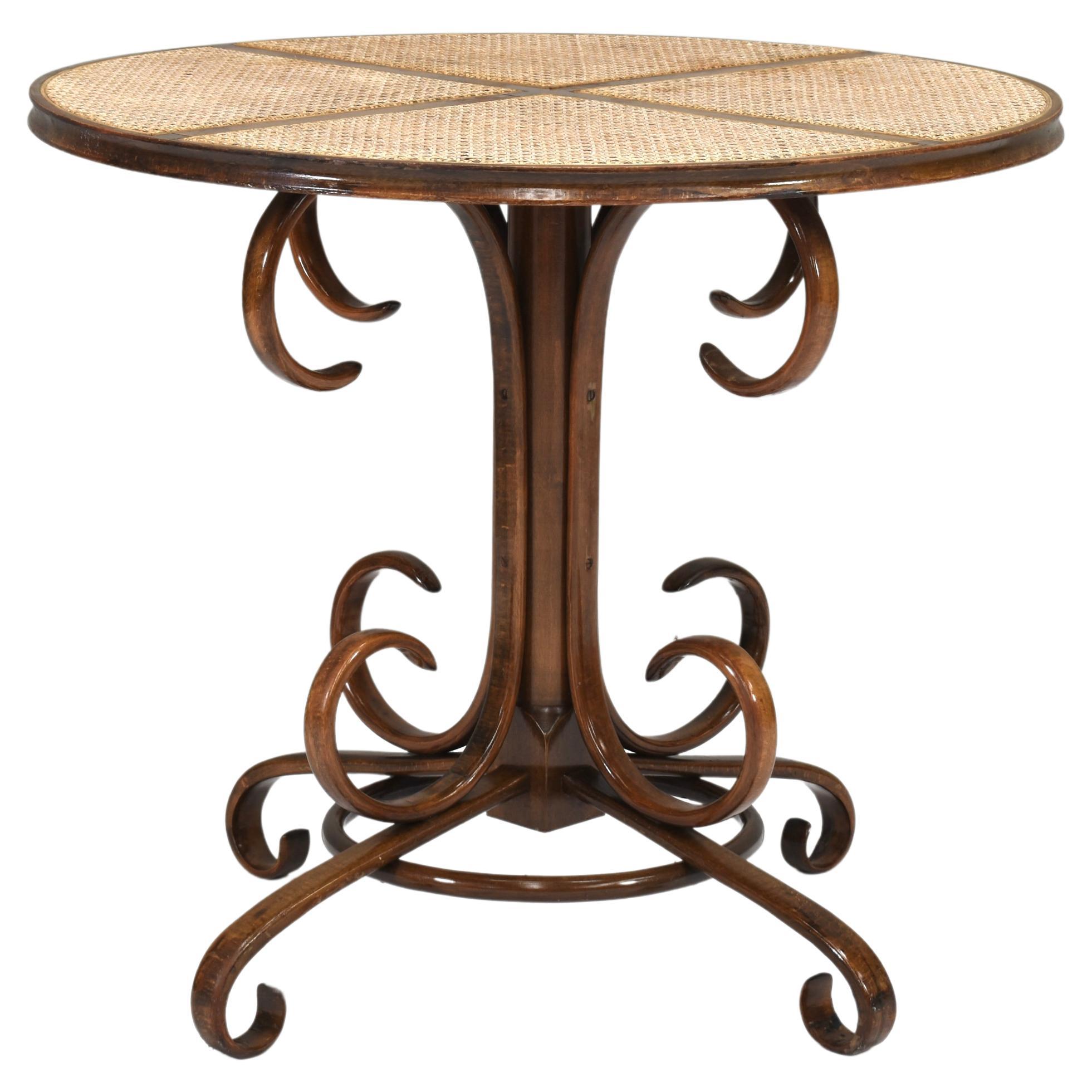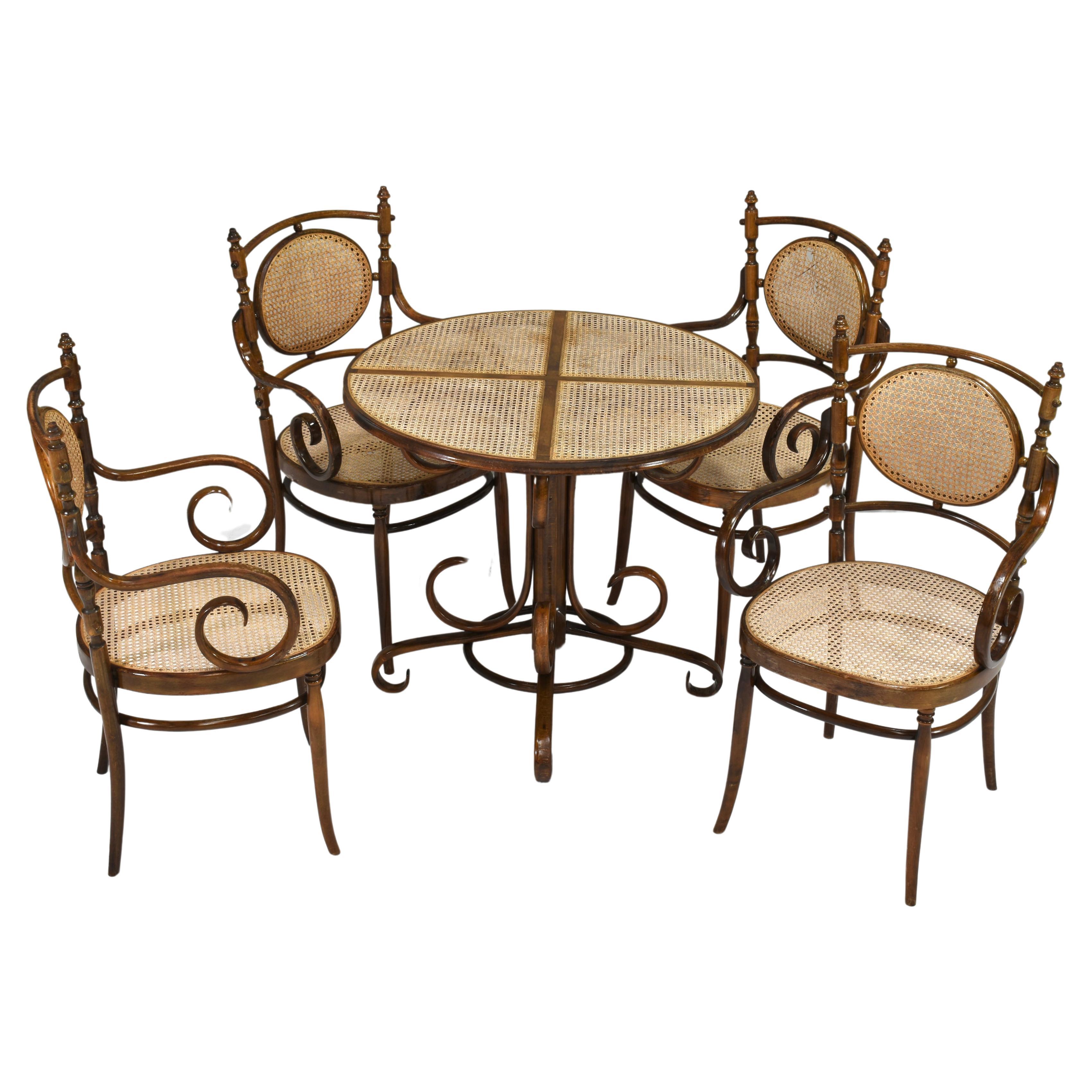Austrian Thonet Bentwood Black Distressed Dining Set Table 4 Chairs, 5 Pieces
About the Item
- Creator:Thonet (Manufacturer)
- Dimensions:Height: 31.5 in (80.01 cm)Width: 18.5 in (46.99 cm)Depth: 20 in (50.8 cm)
- Sold As:Set of 5
- Style:Art Deco (Of the Period)
- Materials and Techniques:
- Place of Origin:
- Period:
- Date of Manufacture:Early 1900s
- Condition:Wear consistent with age and use. Top of table and leaf show notable wear and can stand to be refinished. Chairs in great condition.
- Seller Location:Philadelphia, PA
- Reference Number:1stDibs: LU934122454532
Thonet
For more than 180 years, Thonet — or Gebrüder Thonet — has produced elegant and durable tables and cabinets as well as chairs, stools and other seating that wholly blur the lines between art and design. Widely known as a trailblazer in the use of bentwood in furniture, the European manufacturer has reimagined the places in which we gather.
Noted for his skill in parquetry, German-Austrian company founder Michael Thonet received an invitation from Austrian Chancellor Prince Metternich to contribute Neo-Rococo interiors to the Liechtenstein City Palace in Vienna. The Boppard-born Thonet had honed his carpentry skills in his father’s workshop, where he carried out experiments with plywood and modified the Biedermeier chairs that populated the studio.
Thonet’s work for the chancellor raised his profile, and the cabinetmaker gained international recognition, including at London’s Great Exhibition of 1851, which featured works created by members of the Arts and Crafts movement as well as industrial products of the day. Thonet showed a range of furniture at the fair and won the bronze medal for his bentwood chairs. He incorporated his family’s company, the Thonet Brothers, with his sons in 1853.
Bentwood furniture dates as far back as the Middle Ages, but it is the 19th-century cabinetmaker Thonet who is most often associated with this now-classic technique. Thonet in 1856 patented a method for bending solid wood through the use of steam, and from there, the bentwood look skyrocketed to furniture fame. The works of renowned mid-century modern designers such as Alvar Aalto, Arne Jacobsen, and Charles and Ray Eames that put this technological advancement to use would not be as extensive or celebrated were it not for the efforts of the pioneering Thonet.
Considered the world’s oldest mass-produced chair, Michael Thonet’s ubiquitous Chair No. 14 demonstrated that his patented bentwood technology made it possible to efficiently produce furniture on an industrial scale. Now known as the 214, it won the German Sustainability Award Design for 2021, a recognition of the company’s commitment to environmentally responsible production.
Often called the Coffee House chair — the company’s first substantial order was for a Viennese coffeehouse — the No. 14 remains an icon. Thonet originally designed the chair in 1859, and it is considered the starting point for modern furniture.
The bentwood process opened doors — there were investments in machinery and new industrial processes, and the business began mass-producing furniture. By the end of the 1850s, there were additional Thonet workshops in Eastern Europe and hundreds of employees. Michael Thonet’s reputation attracted the attention of notable architects including Otto Wagner, Marcel Breuer and Ludwig Mies van der Rohe.
The No. 14 was followed by the No. 18, or the Bistro chair, in 1867, and the 209, or the Architect’s chair, of which Le Corbusier was a fan. (The influential Swiss-French architect and designer used Thonet furniture in his Pavillon de l’Esprit Nouveau at the 1925 International Exposition of Decorative Arts in Paris.)
Thonet’s chair designs also appeared in artwork by Toulouse-Lautrec, John Sloan and Henri Matisse in his Interior with a Violin Case. The noteworthy Thonet rocking chair remains a marvel of construction — in the middle of the 19th century, Michael produced a series of rockers in which the different curved parts were integrated into fluid, sinuous wholes. Thanks to Thonet, the humble rocker acquired something unexpected: style. It was captured in the paintings of Pablo Picasso, Pierre-Auguste Renoir and James Tissot.
Thonet is currently split into global divisions. Thonet Industries U.S.A. was acquired in 1987 by Shelby Williams and joined the CF Group in 1999, while the Thonet brand in Germany is owned by Thonet GmbH.
Find a collection of antique Thonet furniture on 1stDibs.
- ShippingRetrieving quote...Ships From: Philadelphia, PA
- Return PolicyA return for this item may be initiated within 7 days of delivery.
- Vintage Metal Thonet Bentwood Austrian Style Bistro Dining Chairs, Set of 4Located in Philadelphia, PAVintage Metal Thonet Bentwood Austrian style Bistro dining chairs - set of 4. Item features metal frames, "bentwood" style, very rare model, upholstered seats, very nice vintage set,...Category
Late 20th Century North American Art Nouveau Dining Room Chairs
MaterialsMetal
- Vintage Thonet Mid Century Modern Bentwood Walnut Dining Chairs - Set of 4By ThonetLocated in Philadelphia, PAVintage Thonet Mid Century Modern Bentwood Walnut Dining Chairs - Set of 4. Circa Mid 20th Century. Measurements: 31.5" H x 17" W x 22" D x 1...Category
Mid-20th Century Mid-Century Modern Dining Room Chairs
MaterialsWalnut
- Antique Michael Thonet #4 Bentwood & Cane Cafe Daum Bistro Dining Chair - a PairBy Michael ThonetLocated in Philadelphia, PAAntique Michael Thonet #4 Bentwood & Cane Cafe Daum Bistro Dining Chair - a Pair. Circa early 20th century. Measurements: 36" H x 17" W x 22" D x 18" Seat height.Category
Early 20th Century Art Nouveau Dining Room Chairs
MaterialsCane, Wood
- Vintage Baumann 83 Parisian Bistro Bentwood Dining Chairs, Set of 6By W. Baumann & Co.Located in Philadelphia, PAVintage Baumann 83 Parisian Bistro Bentwood Dining Chairs - Set of 6. Item features (6) side chairs, beautiful wood grain, original stamp, very nice vi...Category
Vintage 1970s Art Deco Dining Room Chairs
MaterialsBentwood
- Italian Hollywood Regency Distressed Gold Gilt Iron Scalloped Glass Coffee TableLocated in Philadelphia, PAItalian Hollywood Regency distressed gold gilt iron scalloped glass coffee table. Item features heavy iron scrollwork base with tassels, thick scalloped s...Category
Mid-20th Century Italian Hollywood Regency Coffee and Cocktail Tables
MaterialsIron
- Chinese Black Lacquer Mother of Pearl Oval Nesting Coffee Table Set 6 Stools - ALocated in Philadelphia, PAVintage Chinese Black Lacquer Mother of Pearl Oval Nesting Coffee Table Set - 6 Stools - A. Item features a custom oval glass top, black lacq...Category
Late 20th Century Chinese Export Coffee and Cocktail Tables
MaterialsMother-of-Pearl, Wood
- Thonet Bentwood Side Table, Design by Josef Hoffmann, Austria ca. 1906By Josef Hoffmann, ThonetLocated in Lichtenberg, ATRemarkable round Art Nouveau coffee table "Fledermaus" designed by the famous Austrian architect and founder of the "Wiener Werkstaette" Josef Hoffma...Category
Early 20th Century Austrian Art Nouveau Coffee and Cocktail Tables
MaterialsBeech
- Thonet Bentwood Chairs with Table, Art Nouveau Seating Set, Austria, circa 1915By Gebrüder Thonet Vienna GmbHLocated in Lichtenberg, ATBeautiful bentwood seating set made by the famous Austrian manufactory of Thonet around 1915. This artfully processed Art Nouveau seating set consists of four exceptional craftedb chairs, all made of fine beechwood that has been bent under steam and high pressure to get this outstanding looking result. All chairs have been newly upholstered with the original, renowned "Vienna mesh", typical for these kind of chairs. The very special design with beautiful arranged high backrests is absolutely matchless. A lovely round beechwood table with unique designed feet and an additional "floating" compartment finalizes the look of this remarkable Thonet suite...Category
Early 20th Century Austrian Art Nouveau Chairs
MaterialsBeech, Bentwood
- Black Thonet Side TableBy ThonetLocated in Banská Štiavnica, SKBlack Thonet side table. Professionally stained and repolished.Category
Vintage 1930s Austrian Vienna Secession Coffee and Cocktail Tables
MaterialsBrass
- Coffee Table Thonet Marble Top Austria Jugenstil, 1910By ThonetLocated in Vienna, ATCoffee table manufactured by Thonet in 1910. The base is made of cast iron and two stained beech feet. At the end of the feet is a covered with a corrugated metal sheet. The marble t...Category
Early 20th Century Austrian Jugendstil Coffee and Cocktail Tables
MaterialsMarble, Metal
- Early Michael Thonet Bistro Dining Table in Bentwood and Cane - AustriaBy Michael Thonet, ThonetLocated in Pijnacker, Zuid-HollandBistro dining table in bentwood and cane designed by Michael Thonet. Originally designed in the 1860s and produced by Thonet in the 20th century by multiple factories. Size: chairs: 57x49x96.5 seat height 46 Arm height 67 centimeter table: ø85.5 height 75 centimeter Condition: used. The lacquer has worn out on some places. The stained beech wood has discoloration. Cane in the table top is good. The cane in two seats is damaged. The cane in one back is damaged. One arm has a crack in a curve. Some small wood details are missing. The cane can be repaired or replaced professionally on request. Michael Thonet The development of bentwood for use in furniture is one of history’s most significant innovations in design. A range of renowned mid-century modern designers such as Alvar Aalto, Arne Jacobsen, and Charles and Ray Eames drew heavily on this technological advancement, and the success of their enduring works owes to the efforts of pioneering German-Austrian industrialist and designer Michael Thonet — founder of Thonet and widely considered the father of bentwood furniture. Bentwood furniture dates as far back as the Middle Ages, but it is the 19th-century cabinetmaker and master of parquetry Michael Thonet who is most often associated with this now-classic technique. Thonet in 1856 patented a method for bending solid wood through the use of steam, and from there, the bentwood look skyrocketed to furniture fame. He experimented with bending birch rods into rounded shapes — forming delicately seductive, curving Art Nouveau creations that were a daring departure from the heavy, hand-carved designs attributed to his contemporaries. The Boppard-born Thonet honed his carpentry skills in his father’s workshop, where he carried out experiments with plywood and modified the Biedermeier chairs that populated the studio. He received an invitation from Austrian Chancellor Prince Metternich to contribute Neo-Rococo interiors to the Liechtenstein City Palace in Vienna. From there, the cabinetmaker gained international recognition, including at London’s Great Exhibition of 1851, which featured works created by members of the Arts and Crafts movement as well as industrial products. Thonet showed a range of furniture at the fair and won the bronze medal for his bentwood chairs. He incorporated his family’s company, the Thonet Brothers — or Gebrüder Thonet — with his sons in 1853. Considered the world’s oldest mass-produced chair, Michael Thonet’s ubiquitous Chair No. 14 demonstrated that his patented bentwood technology made it possible to efficiently produce furniture on an industrial scale. Often called the Coffee House chair — the company’s first substantial order was for a Viennese coffeehouse — the No. 14 remains an icon. Thonet originally designed the chair in 1859, and it is considered the starting point for modern furniture. Composed of just six parts, the chair, with its simple, lightweight design, belies its durability. The No. 14 was followed by the No. 18, or the Bistro chair, in 1867, and the 209, or the Architect’s chair, of which Le Corbusier was a fan. (The influential Swiss-French architect and designer used Thonet furniture in his Pavillon de l’Esprit Nouveau at the 1925 International Exposition of Decorative Arts in Paris.) The business began mass-producing furniture. By the end of the 1850s, there were additional Thonet workshops in Eastern Europe and hundreds of employees. Michael Thonet’s reputation attracted the attention of notable architects including Otto Wagner, Marcel Breuer and Ludwig Mies van der Rohe. Thonet’s patented bentwood technology also yielded an improvement to rocking chairs for his company — in the middle of the 19th century, Michael produced a series of rockers in which the different curved parts were integrated into fluid, sinuous wholes. Thanks to Thonet, the humble rocker acquired something unexpected: style. And bentwood furniture was embraced by a series of design greats — the innovation can be found in the seating that Josef Hoffman designed for Thonet, in the elegant Superleggera chair created by Gio Ponti and Alvar Aalto’s expressive Paimio armchair...Category
Antique 1860s Austrian Rococo Revival Dining Room Tables
MaterialsCane, Bentwood
- Early Michael Thonet N.17 Bistro Dining Set in Bentwood and Cane - AustriaBy Michael Thonet, ThonetLocated in Pijnacker, Zuid-HollandNo. 17 dining set in bentwood and cane 'long john' chairs and table designed by Michael Thonet. Originally designed in the 1860s and produced by Thonet in the 20th century by multiple factories. Size: chairs: 57x49x96.5 seat height 46 Arm height 67 centimeter table: ø85.5 height 75 centimeter Condition: used. The lacquer has worn out on many places. The stained beech wood has discoloration. The cane in two seats is damaged. The cane in one back is damaged. One arm has a crack in a curve. Some small wood details are missing. The cane can be repaired or replaced professionally on request. Michael Thonet The development of bentwood for use in furniture is one of history’s most significant innovations in design. A range of renowned mid-century modern designers such as Alvar Aalto, Arne Jacobsen, and Charles and Ray Eames drew heavily on this technological advancement, and the success of their enduring works owes to the efforts of pioneering German-Austrian industrialist and designer Michael Thonet — founder of Thonet and widely considered the father of bentwood furniture. Bentwood furniture dates as far back as the Middle Ages, but it is the 19th-century cabinetmaker and master of parquetry Michael Thonet who is most often associated with this now-classic technique. Thonet in 1856 patented a method for bending solid wood through the use of steam, and from there, the bentwood look skyrocketed to furniture fame. He experimented with bending birch rods into rounded shapes — forming delicately seductive, curving Art Nouveau creations that were a daring departure from the heavy, hand-carved designs attributed to his contemporaries. The Boppard-born Thonet honed his carpentry skills in his father’s workshop, where he carried out experiments with plywood and modified the Biedermeier chairs that populated the studio. He received an invitation from Austrian Chancellor Prince Metternich to contribute Neo-Rococo interiors to the Liechtenstein City Palace in Vienna. From there, the cabinetmaker gained international recognition, including at London’s Great Exhibition of 1851, which featured works created by members of the Arts and Crafts movement as well as industrial products. Thonet showed a range of furniture at the fair and won the bronze medal for his bentwood chairs. He incorporated his family’s company, the Thonet Brothers — or Gebrüder Thonet — with his sons in 1853. Considered the world’s oldest mass-produced chair, Michael Thonet’s ubiquitous Chair No. 14 demonstrated that his patented bentwood technology made it possible to efficiently produce furniture on an industrial scale. Often called the Coffee House chair — the company’s first substantial order was for a Viennese coffeehouse — the No. 14 remains an icon. Thonet originally designed the chair in 1859, and it is considered the starting point for modern furniture. Composed of just six parts, the chair, with its simple, lightweight design, belies its durability. The No. 14 was followed by the No. 18, or the Bistro chair, in 1867, and the 209, or the Architect’s chair, of which Le Corbusier was a fan. (The influential Swiss-French architect and designer used Thonet furniture in his Pavillon de l’Esprit Nouveau at the 1925 International Exposition of Decorative Arts in Paris.) The business began mass-producing furniture. By the end of the 1850s, there were additional Thonet workshops in Eastern Europe and hundreds of employees. Michael Thonet’s reputation attracted the attention of notable architects including Otto Wagner, Marcel Breuer and Ludwig Mies van der Rohe. Thonet’s patented bentwood technology also yielded an improvement to rocking chairs for his company — in the middle of the 19th century, Michael produced a series of rockers in which the different curved parts were integrated into fluid, sinuous wholes. Thanks to Thonet, the humble rocker acquired something unexpected: style. And bentwood furniture was embraced by a series of design greats — the innovation can be found in the seating that Josef Hoffman designed for Thonet, in the elegant Superleggera chair created by Gio Ponti and Alvar Aalto’s expressive Paimio armchair...Category
Antique 1860s Austrian Rococo Revival Dining Room Sets
MaterialsCane, Bentwood
